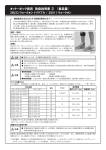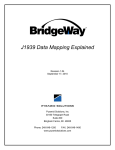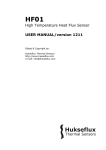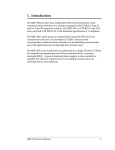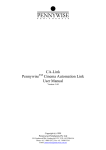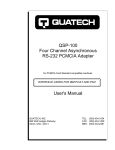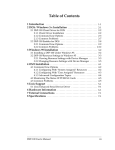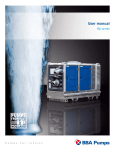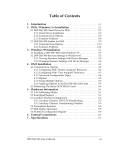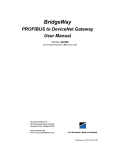Download Adobe Acrobat PDF format
Transcript
ControlNet ISA Interface Adapter (Catalog No. CN-1000) Installation Guide 1850 Research Drive Suite 300 Troy, Michigan 48083 TEL: FAX: Web: (248) 524-3890 1-888-PYRASOL (248) 524-3899 www.pyramid-solutions.com Pyramid Solutions Table of Contents 1. OVERVIEW ..................................................................................................................................................................1 2. FEATURES ....................................................................................................................................................................2 3. CN-1000 DIAGRAM...................................................................................................................................................3 4. CONFIGURATION......................................................................................................................................................4 4.1 BASE M EMORY A DDRESS......................................................................................................................................4 4.2 8/16 BIT HOST A CCESS SELECT ...........................................................................................................................6 4.3 MAC ID....................................................................................................................................................................6 4.4 INTERRUPT CONFIGURATION ..............................................................................................................................7 5. ADDITIONAL PORTS/JUMPERS...........................................................................................................................8 5.1 GENERAL REGISTER(DEBUG) PORT .....................................................................................................................8 5.2 ISP PORT ..................................................................................................................................................................8 5.3 INT 1 JUMPERS........................................................................................................................................................8 6. INSTALLATION..........................................................................................................................................................9 7. STATUS INDICATOR LIGHTS............................................................................................................................. 10 APPENDIX A - RUNNING THE CARD DIAGNOSTICS ....................................................................................... 11 APPENDIX B - ERROR CODES ................................................................................................................................ 16 APPENDIX C - COMPATIBLE SOFTWARE.......................................................................................................... 17 APPENDIX D - FIRMWARE UPDATES ................................................................................................................... 18 APPENDIX E - WARRANTY INFORMATION....................................................................................................... 19 Document Number CN1000-0198-001 May 13, 1999 i Pyramid Solutions Contents Included in Package The package that you ordered should include the following items: Item Number Quantity Description 1 2 3 1 1 1 CN-1000 Card CN-1000 Installation Guide CN-1000 Utility disk containing diagnostic program, flash update utilities and readme file Document Number CN1000-0198-001 May 13, 1999 ii Pyramid Solutions Handling the Card Warning: The CN-1000 card contains electronic components which are highly sensitive to electrostatic discharge (ESD). Handling the card without the proper ESD protection can cause internal damage to the card. Please take the following precautions to protect against ESD damage: • • • Always store the card in its protective bag when not in use. Before handling the card, be sure to wear a static strap and touch a grounded object to release any built-up static charge. Never touch the backplane connector or interface connector pins of the CN-1000 card. Document Number CN1000-0198-001 May 13, 1999 iii Pyramid Solutions Specifications The operating parameters listed below describe the environment for the CN-1000 card. In addition, the CN-1000 card should not exceed the specifications defined in the documentation for your computer. Power Requirements Operating Temperature Storage Temperature Operating Humidity Document Number CN1000-0198-001 May 13, 1999 5V ± 5%, 400mA Typical 0°C to 50°C -40°C to 85°C 5% to 95% non-condensing iv Pyramid Solutions 1. Overview The CN-1000 is an ISA half-size card for a standard AT expansion slot which allows a host computer to communicate on a ControlNet™ network either through redundant coaxial cables or the isolated NAP port. The CN-1000 is shipped ready for use with existing software products to allow ControlNet developers the ability to create custom Adapter Class or Message Class products for embedded or PC based applications. Refer to Appendix B for a list of the software that is currently compatible with the CN-1000. ControlNet is a trademark of ControlNet International, Ltd. Document Number CN1000-0198-001 May 13, 1999 1 Pyramid Solutions 2. Features The CN-1000 provides the following features: ControlNet Interface: • • • • • Fully compatible with ControlNet specification version 1.03. Supports 100 pin MQFP CNA10 with external FLASH interface. Isolated Network Access Port (NAP) Redundant coaxial ControlNet connections. LED network status indicators PC Interface: • • • • • • • • Compact half-size card Supports 8/16 bit ISA interface. Host interface to FLASH allows dynamic downloading of communication code. Requires only 4K of host memory. Host can support multiple CN-1000 cards No host I/O space required. Memory based PCB configuration - base address DIP switch selectable. Interrupt jumper selectable Document Number CN1000-0198-001 May 13, 1999 2 Pyramid Solutions 3. CN-1000 Diagram S1 S2 FLASH General Register CNA10 Status LED's ISP PORT 16 Bit Mode NAP Port PAL BNC Connector - A INT0 BNC Connector - B INT1 Diagnostic status indicators Network Access Port (NAP) RJ-45 Connector for connecting programming terminals to devices on a ControlNet network Channel A Redundant media BNC connectors A BNC Connectors for connecting directly to a ControlNet network Channel B B Document Number CN1000-0198-001 May 13, 1999 3 Pyramid Solutions 4. Configuration Before installing the CN-1000 card, the following must be configured on the card: • • • Base Memory Address Host Interface Access type (8 or 16-bit) CN-1000 card’s interrupt. 4.1 Base Memory Address The CN-1000 card interfaces to the PC via a 4 Kbyte dual port memory. This dual port memory must be mapped to an unoccupied, contiguous 4 Kbyte host memory address space, and is restricted to addresses in the range C000:0000 to EF00:0000. NOTE: The CN-1000 card’s dual port memory must be mapped to an unoccupied 4 Kbyte host memory region in order to avoid conflicts with other interface cards and system memory. If a conflict exists, the system will not operate properly. In addition, when using a 386 or greater host PC, caching and shadow memory must be disabled for the 4 Kbytes of memory used by the CN-1000 card. Document Number CN1000-0198-001 May 13, 1999 4 Pyramid Solutions The CN-1000 base address is configured using switches S1 and S2. Warning: Be careful not to touch other components on the CN-1000 card when setting the switches or jumpers. The following table illustrates various CN-1000 card Base Memory Address Configurations: S2-1 S2-2 S1-1 S1-2 S1-3 S1-4 Closed Closed Closed Closed Closed Closed Closed Closed Closed Closed Closed Closed Closed Closed Closed Closed Closed Open Closed Closed Closed Closed Closed Closed Closed Closed Closed Closed Closed Closed Closed Closed Closed Closed Open Closed Closed Closed Closed Closed Closed Closed Closed Closed Open Open Open Open Open Open Open Open Closed Closed Closed Closed Closed Closed Open Open Open Open Closed Closed Closed Closed Open Open Open Open Closed Closed Closed Closed Open Open Closed Closed Open Open Closed Closed Open Open Closed Closed Open Open Closed Closed Closed Open Closed Open Closed Open Closed Open Closed Open Closed Open Closed Open Closed Open Closed Closed Document Number CN1000-0198-001 May 13, 1999 Base Address C000:0000 C100:0000 C200:0000 C300:0000 C400:0000 C500:0000 C600:0000 C700:0000 C800:0000 C900:0000 CA00:0000 CB00:0000 CC00:0000 CD00:0000 CE00:0000 CF00:0000 D000:0000 E000:0000 5 Pyramid Solutions 4.2 8/16 Bit Host Access Select The Host PC communicates with the CN-1000 card via the PC’s expansion slot data bus. This bus on the PC can support either 8 or a 16 bit devices. The default configuration is for 16 bit host access. Jumper P4 on the CN-1000 card should be populated for proper operation of the software applications listed in Appendix B. 8-Bit Host Access 16-Bit Host Access Jumper: Unpopulated Jumper: Populated Warning: You must not place this card in an 8-bit expansion slot. Improper operation and damage to the card will result. Warning: Be careful not to touch other components on the CN-1000 card when setting the switches or jumpers. 4.3 MAC ID The CN-1000’s MAC ID must be configured by the software application via the dual port memory. The default MAC ID is 0. NOTE: When the CN-1000 card’s MAC ID is set to 0, the card will be off-line. The CN-1000 won’t join the network until a valid MAC ID is configured. Document Number CN1000-0198-001 May 13, 1999 6 Pyramid Solutions 4.4 Interrupt Configuration The CN-1000 provides a single interrupt to the PC. The interrupt can be configured for one of the following PC interrupts: IRQ3, IRQ4, IRQ5, IRQ7, IRQ10, IRQ11, IRQ12, or IRQ15. The interrupt is configured via Jumper P5 on the CN-1000 card. The table below summarizes the associated interrupt configurations for Jumper P5: Pins Shorted 1 and 2 3 and 4 5 and 6 7 and 8 9 and 10 11 and 12 13 and 14 15 and 16 Function IRQ-3 Selected IRQ-4 Selected IRQ-5 Selected IRQ-7 Selected IRQ-10 Selected IRQ-11 Selected IRQ-12 Selected IRQ-15 Selected Document Number CN1000-0198-001 May 13, 1999 7 Pyramid Solutions 5. Additional Ports/Jumpers 5.1 General Register(Debug) Port The General Register Port (P8) is used for monitoring various signals for software development purposes. The signals on this port are defined as follows: Pin P8-2 P8-4 Label GND CLKOUT P8-6 P8-8 P8-10 P8-12 P8-14 G_NET_EN B VCC VCC MONITOR TONE P8-16 GND Description Ground 10 MHz output clock used for synchronous transmit media. This is an inverted version of the TxClock provided on the ASIC. Active high global network transmit enable. +5 Volt Supply +5 Volt Supply Reserved for future use. Output pin that provides a 100 nsec pulse at every tone (the start of each Network Update Time (NUT)) Ground 5.2 ISP Port The ISP Port (P1) is used for programming various electronic components on the CN-1000 card and should be left unused. 5.3 INT 1 Jumpers The INT 1 Jumpers (P6) are reserved for future use. Document Number CN1000-0198-001 May 13, 1999 8 Pyramid Solutions 6. Installation 1) Power down the computer by turning off power switch. Important: When you remove the AC power cord from the PC, you lose the chassis ground. The ESD protection is lost. 2) Remove computer cover to gain access to computer motherboard. 3) Select a vacant 16 or 32 bit expansion slot. The CN-1000 card will only function in a 16 or 32 bit ISA/EISA expansion slot. 4) Remove the vacant expansion slot blank (rear bracket) by loosening the screw on the back of the computer. Important: Before handling the card, be sure to wear a static strap and touch a grounded object to release any built-up static charge. 5) Before you insert the card in the vacant slot, make sure you have correctly set all of the jumpers and switches on the card. 6) Insert the card into the edge connector and tighten the expansion slot screw. 7) Turn the computer on to verify that the system starts up as it did previously. 8) If the system boots up as it previously did, run the diagnostic tests for the CN-1000 card (refer to Appendix A for instructions on running the diagnostic software). 9) If the diagnostic tests pass, replace the computer cover. Document Number CN1000-0198-001 May 13, 1999 9 Pyramid Solutions 7. Status Indicator Lights The status indicator lights on the CN-1000 card give you information about the card and the network when you are connected via the BNC connectors. The table below outlines the states and explains what each state means to you and the action you should take, if any, to correct the state. A and B LED’s Off Steady red Alternating red/green Alternating red/off Cause No power Faulted unit Self-test Incorrect node configuration Action None or power up Cycle power or reset unit None Check network address and other ControlNet configuration parameters A or B LED’s Off Cause Channel disabled Steady green Flashing green/off Flashing green/off Normal operation Temporary errors Node is not configured to go online Media fault Action Program network for redundant media if needed None None, node will self-correct Make sure the configuration node is present and working Check media for broken cables, loose connectors, missing terminators, etc. Cycle power or reset unit Flashing red/off Flashing red/green Document Number CN1000-0198-001 May 13, 1999 Incorrect network configuration 10 Pyramid Solutions Appendix A - Running the Card Diagnostics The CN1000 Diagnostic Software provides a simple set of displays and controls to allow a CN1000 installation to be verified. The software is a DOS application. It must be run in DOS; it cannot be run from within Windows. Running the Diagnostics 1. Using Command Line Arguments. The command line arguments for the Diagnostic Software are used to specify the hardware parameters to be used by the software to access the CN-1000 test card. The command line syntax is as follows. CN1000 [?] [-dDP_Addr] [-iIrq] [-mMacId] [-o] All arguments are optional and will default to the values described below if they are not used. Each argument is described below. ? Display an explanation of the command line syntax. -dDP_Addr Set the dual port base address segment to DP_Addr. This value is assumed to be in hexadecimal. The default value is D000. -iIrq Set the interrupt request number to Irq. The default value is 12. -mMacId Set the MAC ID of the CN-1000 to MacId. The default value is 0. If the MAC ID is set to 0, the CN-1000 will be initialized, but will not attempt to join the network. -o Enable support of old CNA10 test cards (Allen-Bradley cards made before the CN-1000). The default value is to support the CN-1000 card. Document Number CN1000-0198-001 May 13, 1999 11 Pyramid Solutions The following example command line sets up the Diagnostic Software to interface to a CN1000 with a dual port address of E000:0000, an IRQ of 5, and set the MAC ID to 15. CN1000 -dE000 -i5 -m15 2. Using the Optional Configuration File The command line arguments can also be stored in a configuration file, CN1000.CFG. This file must be present in the same directory where the CN1000.EXE executable is stored and run. If the software detects the existence of the CN1000.CFG file, the parameters are read from the file first, then any command line arguments, if any, are processed. Hence, the command line arguments can be used to override any configuration file settings. The configuration file is a text file which can be edited using any text editor. The components of the configuration file are as follows: Keyword /* */ DpSeg: Arguments MacId: [Base Address] [IRQ Number] [MAC ID] Card: small, new Irq: Description Open comment. Everything in the file after this will be ignored until a Close Comment sequence is found. Close comment Base segment address of the CN1000 test card’s dual port memory, for example 0xD000 Interrupt number for the CN1000 test card. (3,4,5,7,10,11,12, or 15) MAC ID value to be used by the CN1000 test card when it joins the network Small indicates that an old CNA10 test card is being used. New indicates that the Pyramid Solutions CN-1000 is being used. Document Number CN1000-0198-001 May 13, 1999 12 Pyramid Solutions User Interface The user interface displays the current status of the test card, and is updated in real time. The following parameters are displayed. • MAC ID • Network mode • Elapsed time, in ASIC timer ticks, since the diagnostic software was started • LED status • Channel A and B network status • Dual port base memory address • IRQ number • Test card firmware revision • Identity information, including vendor ID, device type, device code, device name, and device serial number. There are only 2 interactive commands available to the user of the Diagnostic Software. • <Esc> will exit the software and return to DOS • <F1> will display an explanation of the parameters displayed by the software. Installation Verification When the Diagnostic Software is started, it will verify that the CN-1000 test card is set up correctly to match the software parameters. If the status display appears and is updated after an initialization period (usually 5 seconds or less), the card is set up correctly for the memory and interrupt parameters that were used to start the software. The following sections describe the Diagnostic Software behavior in various typical installation scenarios. 1. Zero MAC ID The status display should show the following values if the software was started with a MAC ID of 0. • The ASIC time should be running • MAC ID = ‘XXX’ • Net Mode = ‘Power Up’ • LED's: both channels flashing green • Channel A = ‘Temp error’ Document Number CN1000-0198-001 May 13, 1999 13 Pyramid Solutions • Channel B = ‘Temp error’ 2. Non-Zero MAC ID, No Active Network The status display should show the following values if the software was started with a valid MAC ID, but no active network (either no other nodes, or no connection). • The ASIC time should be running • MAC ID = the selected MAC ID • Net Mode = ‘Chk 4 Cable’ • LED's: both channels flashing red • Channel A = ‘Lonely’ • Channel B = ‘Lonely’ 3. Non-Zero MAC ID, Active Network On 1 Channel The status display should show the following values if the software was started with a valid MAC ID and the network has other active nodes, but only 1 network channel is connected • The ASIC time should be running • MAC ID = the selected MAC ID • Net Mode = ‘On Line’ • LED's: solid green on the connected channel, flashing red on the unconnected channel • Channel A = ‘Network OK’ if connected, ‘Lonely’ if unconnected • Channel B = ‘Network OK’ if connected, ‘Lonely’ if unconnected 4. Non-Zero MAC ID, Active Network On Both Channels The status display should show the following values if the software was started with a valid MAC ID, the network has other active nodes, and both channels are connected • The ASIC time should be running • MAC ID = the selected MAC ID • Net Mode = ‘On Line’ • LED's: both channels solid green • Channel A = ‘Network OK’ • Channel B = ‘Network OK’ Document Number CN1000-0198-001 May 13, 1999 14 Pyramid Solutions 5. Non-Zero MAC ID, Active Network, Duplicate MAC ID The status display should show the following values if the software was started with a valid MAC ID, but the MAC ID is the same as another node on the network. • The ASIC time should be running • MAC ID = the selected MAC ID • Net Mode = ‘Dup Node’ • LED's: railroad red - alternating flashing red • Channel A = ‘Rogue’ • Channel B = ‘Rogue’ 6. Incorrect Memory Base Address If the value specified for the dual port memory base address is incorrect, or the CN-1000 is not working correctly, the Diagnostic Software will exit with the following error. MEMORY ERROR: Unable to initialize card at Address XXXX:0000 Where XXXX is the address parameter specified to the software. 7. Incorrect IRQ Number If the value specified for the interrupt request number is incorrect, or the CN-1000 is not working correctly, the Diagnostic Software will exit with the following error. IRQ ERROR: Unable to capture interrupt at IRQ XX Where XX is the IRQ parameter specified to the software. Document Number CN1000-0198-001 May 13, 1999 15 Pyramid Solutions Appendix B – Error Codes The following is a list of possible error codes encountered: Fault Code 0x704 0x710 0x711 0x725 Description Explanation/Resolution CD_COMM_PROC_SELFTEST_F AIL The diagnostic utility will exit with fault code 0x704 if it is executed with a malformed or incorrect Base Memory Address (dp_addr). To fix this problem, run the utility with the Base Memory Address (dp_addr) that the CN-1000 is configured for. Look at the table on page 5 of the user manual for the correct Base Memory Address Configurations. CD_INCOMPATIBLE_ASIC_FIR The diagnostic utility will exit with fault code MWARE 0x710 if the firmware version running on the CN-1000 is not version 1.3.17 or later. To fix this problem, upgrade to the latest firmware and diagnostic utility release. The latest release can be found on the Pyramid Solutions Web Site. CD_MAC_PROC_SELFTEST_FAI The diagnostic utility will exit with fault code L 0x704 if it is executed with a malformed or incorrect Base Memory Address (dp_addr). To fix this problem, run the utility with the Base Memory Address (dp_addr) that the CN-1000 is configured for. See the table on page 5 of the user manual for the correct Base Memory Address Configurations. CD_UNSUPPORTED_INT_NUMB The diagnostic utility will exit with fault code ER 0x725 if it is executed with an invalid IRQ. To fix this problem, run the utility with the IRQ that the CN-1000 is configured for. See page 7 of the user manual for a list of valid IRQs. Document Number CN1000-0198-001 May 13, 1999 16 Pyramid Solutions Appendix C - Compatible Software The CN-1000 card is currently compatible with the following software: • • • ControlNet Conformance Test Software Allen-Bradley’s Adapter Class Example Code, CNA30S Allen-Bradley’s Scanner Class Example Code, CNA40S Document Number CN1000-0198-001 May 13, 1999 17 Pyramid Solutions Appendix D – Firmware Updates The firmware on the CN-1000 needs to be updated to the latest release (version 1.3.17) prior to running the diagnostic application or other software applications. Update instructions are included in the README file located on the Diagnostic Software disk. All firmware or software upgrades for the CN-1000 can be found at: http://www.pyrasol.com/DataCom/support.htm Document Number CN1000-0198-001 May 13, 1999 18 Pyramid Solutions Appendix E - Warranty Information Pyramid Solutions warrants all new products to be free of defects in material and workmanship when applied in the manner for which they were intended and according to Pyramid Solutions’ published information on proper installation. The Warranty period is one year from the date of shipment. Pyramid Solutions will repair or replace, at its option, all products returned to it freight prepaid, which prove upon examination to be within the Warranty definitions and time period. EXCLUSIVE REMEDIES/LIMITATION OF WARRANTY. THE REMEDIES SET FORTH IN THE ABOVE PARAGRAPH ARE CUSTOMER’S EXCLUSIVE REMEDIES FOR BREACH OF WARRANTY. PYRAMID SOLUTIONS DISCLAIMS ALL OTHER WARRANTIES, EXPRESS OR IMPLIED, INCLUDING ANY WARRANTIES OR MERCHANTABILIBY OR FITNESS FOR A PARTICLAR PURPOSE. Limitation of Liability. If the exclusive remedy set forth above should fail, Pyramid Solutions’ liability for all claims brought in connection with any product shall be limited to Customer’s actual direct damages, not to exceed the cost of the products. In any event, Pyramid Solutions shall not be liable for any indirect, incidental, consequential or reliance damages (including negligence and strict liability) and whether or not such damages are foreseen. Limitation on Actions. Any claim arising from or related to this Agreement must be brought within two years after the cause of action arises. Product Returns If it should be necessary to return or exchange items, please contact Pyramid Solutions for a Return Authorization Code. Pyramid Solutions, Inc. 1850 Research Drive, Suite 300 Troy, Michigan 48083-2167 Phone FAX Web (248) 524-3890 1-888-PYRASOL (248) 524-3899 www.Pyramid-Solutions.com Document Number CN1000-0198-001 May 13, 1999 19

























